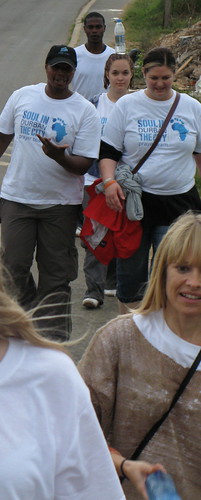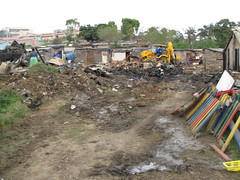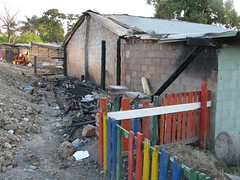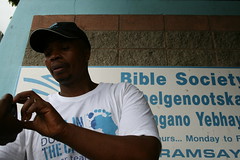The second 'limb' of the cross prayer walk was from the west of Durban, into the centre. We walked it on a Sunday, meaning that we connected with more people in each church as they were already there for their service.
We started the day at Westville Christian Fellowship, a church full of people of all colours, tribes and races. WCF has been multicultural since before apartheid was over - a bold move at the time. You can read their history on their website. We were there for the beginning of their service so were able to worship with them, both for the kids worship (much dancing and actions!) and the 'adult' worship. The worship style that day was fairly similar to what you'd find at Soul Survivor and many other Western churches, although I'm told that they do also incorporate Zulu sword dancing into their services on occasion so we were sorry to have missed that. As we walked on from the church and into Chesterville township, we prayed for the church, who are currently building their own premises in the township with a view to becoming more part of the community.
Initially, this walk took us through a country club and down a road lined with large, affluent housing. Not too far down the road, we passed very close to the Pavillions shopping centre - a large mall built on the edge of the township. It's an amazing contrast to see such wealth and consumerism next to the simplistic shacks of the township. Many of the township's inhabitants work in Pavillions, which was built, in part, to create employment. We stopped by the mall to pray there, for that, for a masonic lodge clearly visible on top of a nearby hill, for recurring accidents which happen at the many busy road junctions in that area , for the hospital and prison nearby, and for various other things.
Beyond the Pavillions we began an 8km walk down Spine Road, a relatively busy and straight road which edges Chesterville Township. There is, for the most part, a small amount of wasteland between the township and the road so it was a little like praying for the township at arms length; disappointing in some ways as it would have been great to be able to be amongst the people, to experience a bit of the culture and to actually be able to talk and pray with people. We prayed into the many issues facing township dwellers across South Africa - high unemployment rates, rising living costs, security, violent xenophobic attacks, alcoholism and other addictions, HIV and AIDS and abuse of children.
It was a long walk. The route isn't particularly attractive or exciting but then we never said it would be. It was hard, walking so long through such poor areas having just come from somewhere at the other end of the scale. The realities of the contrasts of South Africa were ever present that afternoon. But then sometimes prayer is hard. Sometimes prayer is accepting the things you didn't want to see. Sometimes it's pushing on through the tough stuff that seems to never end. It was hard. But it was worth it.
Endless as it seemed, we did eventually reach our turning and began to walk up the hill into Cato Crest. If we'd thought that the contrast between the Pavillions and Chesterville was big, this was bigger. I think Cato Crest is possibly one of the worst shack dwellings I've seen. The shacks are small, very close together and built, seemingly, from whatever materials came to hand. There are people (and chickens!) everywhere, as far as you can see, in every tiny space up and down the hills.
Lucy, Kiran, Andrew and I had visited Cato Crest earlier in the week with Tim, who works in the area, supporting the local church and school and giving out food parcels regularly to families in need. He drove through with us, helping us to finalise our route to the church so that we wouldn't get lost when it came to the walk. Townships aren't always safe places to be, particularly not when you stand out as well as we do - very very white, obviously not locals. People are very wary of foreigners (and often rightly so) so it was important that we knew our way.
 The walk into Cato Crest begins with a climb up a steep hill, which looked a little daunting from the bottom, especially after 8km, but we attacked it with enthusiasm, praying for the area, the people we saw, greeting those who passed us with the few Zulu words we could remember, praying for the developments we could see - the government are slowly tearing down the existing settlements and building low-cost housing in its place. These new buildings are slightly more hardwearing but take up more space than the original shacks, creating a different kind of housing problem.
The walk into Cato Crest begins with a climb up a steep hill, which looked a little daunting from the bottom, especially after 8km, but we attacked it with enthusiasm, praying for the area, the people we saw, greeting those who passed us with the few Zulu words we could remember, praying for the developments we could see - the government are slowly tearing down the existing settlements and building low-cost housing in its place. These new buildings are slightly more hardwearing but take up more space than the original shacks, creating a different kind of housing problem.Having reached the top, we headed on down the other side of the hill towards the church, which sits at the t-junction at the end of the road. The feeling of walking over that hill and reaching the junction was overwhelming. I'd remembered the area around the church as being busy, colourful, rammed full of shacks and houses with people all over the place. If you didn't know the church was there, you'd miss it (as Lucy and I did when we drove through the first time around) as there are so many buildings so close to it. As we walked down towards it this time, all I could see was a big gaping space, filled with debris and a large JCB. The church, thankfully, was still there, although I couldn't see it at first. The whole area looked so different that I honestly thought we'd taken a wrong turning, even though I was fairly confident we'd come the right way (and Lucy, Kiran and Andrew hadn't argued when I made the turnings!). It was a huge shock.
A small metal shipping container with ducks painted on the side helped me to find my bearings and we picked our way through the creche play area into the church. The church itself is barely more than a large shack with simple breeze block walls, a wooden frame and a corrugated metal roof. We walked blinking inside and were directed to some empty seats. It was amazingly dark and took a long time for my eyes to adjust enough to be able to see how many people were inside - around 40. It didn't help that the only window was directly behind Pastor Simon who was mid-sermon as we arrived.
Pastor Simon paused in the middle of his talk (about Paul and Timothy), to welcome us and to explain to his congregation who we were. He also took the time to explain to us that just the night before, there had been a fire and 29 of the shacks had been burnt to the ground, claiming the lives of 8 people, some of them children, and all known to members of the church, hence the large empty patch next to the church, and the blackened walls and beams of the church building. Some of the shacks which had burnt had been almost touching the church building. You can read a newspaper article about this fire at this South African news site.


He also explained that the darkness was due to the xenophobic attacks which took place at the end of May this year. A gang attacked the church, and Pastor Simon's family home next door, looting any valuables and ransacking the rest. They stole the PA system and generator which powered the lights but the church continue to meet and worship in the dim light.
At the end of his talk, which he continued after our arrival in Zulu and English for our benefit, Simon invited us to speak. This was when Siya did his thing! It was an amazing and beautiful moment as Siya came to the front and greeted the church in Zulu (sometimes translating into English so we knew what he was saying). (In case you were wondering, this wasn't a timely gift of spontaneous tongues, Siya was born and brought up in Cape Town). My Zulu isn't good enough (read 'isn't good at all') to know what he said but we reckon it was something to do with Jesus turning our mourning into dancing and how we should praise him even in the sad times. It wasn't long before he had the whole church on their feet, singing, praising and dancing (even us reluctant British dancers). It was fantastic to see God using Siya and his gifts there and to feel the atmosphere which had been sad and heavy, turn to one of joy and praise.
It was a huge privilege to have the opportunity to be able to pray for the people of this church. Siya and Simon invited anyone who wanted prayer to step forward - women first. The team gathered round to pray for the women of the community, allowing God to speak and hoping for a well-placed translator when he did! There are so many practical issues to pray for here; the means to support and feed families, employment for themselves, their husbands and older children, education for the children and so on, but most of these women simply asked that God would increase their faith. What an inspiration - so much obvious need and still their greatest desire is for more faith in God.
Having prayed for the women, we then invited any men to come forward for prayer in a similar way. The men from the team gathered around them to pray for them too.
As we left, we stopped for a few minutes in the playground just outside the church, where a creche runs during the week (the Inkosi Nathi (God with us) Little Disciples Creche and Pre School), to pray for the community. It was hard to find the words with so much around us - the shacks, the people, the fire, the mess it had left...
 Tired, and still a little shocked, we walked back up the hill through the township and on towards the centre, still praying as we walked. We paused a few times on the way back, to pray for Jean's house, visible just up the hill as we walked past, for the Bible Society HQ in Durban and their work, outside Ben, Katie and Bertie's old hose to pray for them as this section of their life draws to a close and they seek God for what comes next, and by Durban Boys High School to pray for the pupils who were playing rugby in the rain!
Tired, and still a little shocked, we walked back up the hill through the township and on towards the centre, still praying as we walked. We paused a few times on the way back, to pray for Jean's house, visible just up the hill as we walked past, for the Bible Society HQ in Durban and their work, outside Ben, Katie and Bertie's old hose to pray for them as this section of their life draws to a close and they seek God for what comes next, and by Durban Boys High School to pray for the pupils who were playing rugby in the rain!We took a break for tea and rusks (not what we British people think of as rusks - more like a very hard shortbread biscuit which tastes great dunked in tea) for the rest of the afternoon as our walk that day was to finish at the St Thomas, Berea, evening service. St Thom's was the church which became home to us for the duration of our stay, as they very kindly hosted the team, providing beds and breakfasts and dealing extremely calmly with our random comings and goings! Rob Taylor, the vicar at St Thoms, was very involved with Soul Survivor in Durban a few years ago and he and his wife, Sue, sons, Paul and Mick, dogs, Wallace and Shadow, and, last but by no means least, cats, Aslan and Foot, welcomed us brilliantly.
The team served at St Thomas in various individual ways whilst we were there, with Katie, Steve, Wendy and Annie getting involved musically in the worship at their evening service, Andrew helping on the technical side and Annie speaking at one of the services towards the end of her stay. We also helped out with the refugees currently situated at the church but that's for another email update...
So we felt very much a part of the church family at St Thoms and it was great to be able to relax and join with them to worship at their evening service, with the opportunity to pray for some of the members at the end.
All in all, a difficult day - our longest walk of the five, with the most contrasts and challenges, the shock of the devastation at Cato Crest but also the privilege, once again, of seeing God at work in His church and the opportunity to be a part of it.
Day 2 Summary:
km walked: 13.7
churches visited: 3
general prayer stuff: unemployment, addiction, consumerism, freemasonry, contrasts, unity, healing
No comments:
Post a Comment